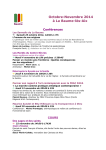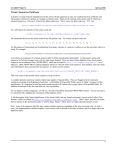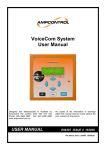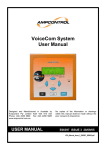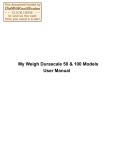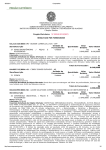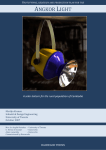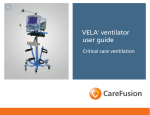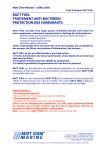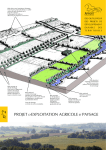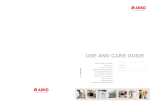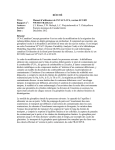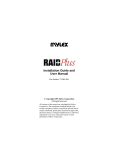Download YLEX intro - Yeastern Biotech Co., Ltd
Transcript
About the Kit Ver. M1127 No part of these protocols may be reproduced in any form or by any mean, transmitted, or translated into a machine language without the permission of YEASTERN BIOTECH CO., LTD. Address: 6F-3, 23 Lane 169, Kang Ning St., Shijr, Taipei, 22180 Taiwan. Tel: +886-2-2695-3922 Fax: +886-2-2695-3979 Email: [email protected] Website: www.yeastern.com Copyright ® 2013 All rights reserved. Yeastern Biotech Co., Ltd. This product is intended to be used for life science research only. It has not been approved for drug or diagnostic purpose. YEASTERN’s products should not be resold, modified for resale, or used to manufacture commercial products without written approval by YEASTERN. YEASTERN guarantees the performance of all products in the manner described in our protocol. The purchaser must determine the suitability of the product for its particular use. Should any product fail to perform satisfactorily due to any reason other than misuse, YEASTERN will replace it free of charge. Copyright ® 2013 All rights reserved. Yeastern Biotech Co., Ltd. Product Use Limitation & Warranty Cat. No. FYY201-1KT FYY301-120P Individual YLEX Expression Kit license agreement 1 Kit Components 3 Introduction 4 Troubleshooting 5 Examples 7 References 9 Product Use and Limitation 9 Notice: • All rights reserved. No part of this protocol may be reproduced in any form or by any means, or transmitted, or translated into a machine language without the permission of Yeastern Biotech Co., Ltd. • This product is intended to be applied for research purpose only. It is not to be used for drug or diagnostic purposes nor is it intended for human and animal use. Yeastern products may not be reproduced, modified for resale, resold or any derivative thereof to the third party. Yeastern Biotech (YEASTERN) grants user a non-exclusive license to use the enclosed YLEX Expression Kit (YLEX KIT) for academic research or for evaluation purposes only. The YLEX KIT is being transferred to user in furtherance of, and reliance on, such license. User may not use the YLEX KIT, or the materials contained therein, for any commercial purpose without a license for such purpose from YEASTERN. Commercial purposes include the use of or sale of expressed proteins as a commercial product, or their use to facilitate research or development of a commercial product. Commercial entities may conduct their evaluation for one year at which time this license automatically terminates. Commercial entities will be contacted by YEASTERN during the evaluation period regarding the purchase of a commercial license. An access to the YLEX KIT must be limited solely to officers, employees or students of the granted or licensed institution, who need access thereto in order to perform the above-described research or evaluation. User must inform each of such officer, employee and student of the provisions of this Agreement and require them to agree, in writing, to be bound by the provisions of this Agreement. User may not distribute the YLEX KIT to another user, even those within user’s own institution. User may transfer modified, altered or original material from the YLEX KIT to a third party following a notification of YEASTERN such that the recipient can be licensed. User may not assign, sub-license, rent, lease, or otherwise transfer this License or any of the rights or obligation hereunder, except as expressly permitted. This License is effective until terminated. User may terminate it at any time by destroying all Yarrowia expression products in his or her control. It will also terminate automatically if user fails to comply with the terms and conditions of the Agreement. User shall, upon termination of the License, destroy all YLEX Expression Kits in his or her control, and so notify YEASTERN in writing. This License Shall be governed in its interpretation and enforcement by the laws of Taiwan. INDIVIDUAL YLEX EXPRESSION KIT LICENSE AGREEMENT Product User Registration Agreement The YLEX Expression Kit is based on the yeast Yarrowia lipolytica. Yarrowia lipolytica was developed into an expression system by scientists at the Institut National de la Recherche Agronomique (INRA), Paris, France for high-level expression of recombinant proteins, which has been patented. Yeastern Biotech has a non-exclusive license to sell the YLEX Expression Kit to scientists for research purposes only, under the terms described below. A Use of YLEX Expression Kit to produce specific protein by commercial corporations requires the user to obtain a commercial license as detailed below; hence, it is advised that the license agreement be read before any use. In any case user does not agree with the license terms, he or she should contact Yeastern Biotech within 10 days for an authorization to return the unused YLEX Expression Kit before receiving a full credit. User agreeing to the terms of this Agreement should complete and return the Product User Registration Agreement to Yeastern Biotech before using the kit. Please complete and return the enclosed Product User Registration Agreement for each YLEX Expression Kit that you purchase. This will serve as a record of your purchase and registration and will allow Yeastern Biotech to provide you with technical support and manual updates. It will also allow Yeastern Biotech to update you on future developments of and improvements to the YLEX Expression Kit. The agreement outlined above becomes effective upon our receipt of your User Registration Card or 10 days following the sale of the YLEX Expression Kit to you. A use of the kit at any time results in immediate obligation to the terms and conditions stated in this Agreement. , Ltd. Copy ch Co. right® 20 rn Biote 14 All rights reserved. Yeaste ., L t d . 14 All rights reserved. Yeaste right® 20 rn Biote Copy ch C o 1 INDIVIDUAL YLEX EXPRESSION KIT LICENSE AGREEMENT Table of Contents Technical Services Yeastern Biotech provides Technical Services to all of our registered YLEX Expression Kit users. Please contact us if you need assistance with the YLEX Expression Kit. 2 Introduction Yeast Strain: Po1g General background of Yarrowia lipolytica The strain Po1g of Yarrowia lipolytica is a derivative of the wild-type strain W29 (ATCC 20460) by a series of genetic modifications. Briefly, the original URA3 gene in the W29 strain was disrupted with the SUC2 gene from Saccharomyces cerevisiae, followed by the introduction of a deletion in the LEU2 gene. Furthermore, the deletion of the XPR2 and AXP genes ensures that Po1g is unable to produce any extracellular protease. In order to allow easy integration of pBR-based expression/secretion vectors, a pBR322 docking platform was integrated at the URA3 locus. (Madzak et al., 2000) Yarrowia lipolytica is a species of non-conventional and GRAS (generally regarded as safe) yeast widely utilized in industrial applications such as organic acid and protein production. As unicellular organism, it has the advantages of E. coli and Saccharomyces cerevisiae in ease of manipulation and growth capacity. But, it also functions as a higher eukaryotic organization able to perform post-translational processing of complex proteins. As compared to S. cerevisiae, Y. lipolytica has certain advantages, such as a mainly co-translational secretion pathway (like in mammalian cells), higher secretion capacity and product yield, less hyperglycosylation on products, and simplicities in scaling-up production. These features make Y. lipolytica very useful as a protein expression system. Furthermore, the whole genome of Yarrowia lipolytica has been sequenced; please check http://cbi.labri.fr/Genolevures/elt/YALI for details. Strain Genotype Phenotype Po1g MatA, leu2-270, ura3-302::URA3, xpr2-332, axp-2 Leu¯, ∆AEP, ∆AXP, Suc+, pBR platform Vectors (Madzak et al., 2000) : Name Amount Expression pYLEX1 (noted as pINA1269 in Madzak et al., 2000) 5 µg Secretion pYLSC1 (noted as pINA1296 in Madzak et al., 2000) 5 µg Primers: (for DNA sequencing purpose) : Type Sequence Amount 6560 F 5’-GAT CCG GCA TGC ACT GAT C-3’ 250 µl 6904 R 5’-AAC ACC GGT GTT GGA CTC AG-3’ 250 µl YLOS Transformation Kit (Chen et al., 1997) : Component Description Storage Temp Quantity YLOS Buffer A mixture of cations and polyethylene glycol Room Temp 12 ml (1.5 ml x 8) Carrier DNA A mixture of single strand DNA for enhancing the transformation efficiency Dispense into 50 µl aliquots, stored at −20°C 0.3 ml DTT powder A reducing agent for enhancing the transformation efficiency Add 0.6 ml of dd-H₂O and sterilized with filter, dispense into 50 µl aliquots, stored at −20°C 3 Product Description YLEX Expression Kit, based on INRA INAPG licensed patent*, provides an easy approach for cloning and expressing a gene of interest in the yeast Yarrowia lipolytica. Using this kit, heterologous protein may be expressed intracellularly or secreted from the cell into medium by selecting respectively the supplied expression vector pYLEX1 or pYLSC1. Using YLEX Expression Kit, heterologous protein expression is driven by a strong hybrid promoter (hp4d) carrying four tandem copies of an upstream activator sequence (UAS1B) from pXPR2 and a minimal pLEU2 fragment. To achieve expression in yeast, pYLEX1 containing a cloned gene of interest is linearized by a selected restriction enzyme to produce an expression cassette that can integrate with high efficiency into the Y. lipolytica genome by homologous recombination with an integrated pBR platform. A leucine gene (LEU2) in pYLEX1 provides for selection of yeast containing an integrated expression cassette by allowing their growth on leucine-free minimal medium. The integrated vector is particularly stable, and targeted monocopy integration allows a direct comparison of the properties of the transformants, which are comparable in terms of locus and copy number. To achieve secretion of protein from yeast cells, the gene of interest is cloned into pYLSC1, downstream from the XPR2 pre region (secretion signal from XPR2 gene), resulting in expression of a secretion signal fusion protein. The XPR2 pre region directs the fusion protein to be efficiently transported through the yeast secretory pathway. The secretion signal fusion protein undergoes sequential processing by signal peptidase and protease in the endoplasmic reticulum and Golgi complex respectively, resulting in the secretion of the native form of the protein of interest into the culture medium. , Ltd. Copy ch Co. right® 20 rn Biote 14 All rights reserved. Yeaste ., L t d . 14 All rights reserved. Yeaste right® 20 rn Biote Copy ch C o Kit Components For more information, please read the articles cited in this user’s manual. * INRA (Institut National de la Recherche Agronomique) and INAPG (Institut National Agronomique Paris-Grignon, renamed AgroParisTech since 2007) 0.185 g 4 , Ltd. Copy ch Co. right® 20 rn Biote 14 All rights reserved. Yeaste ., L t d . 14 All rights reserved. Yeaste right® 20 rn Biote Copy ch C o Troubleshooting Low efficiency of transformation 1. Test various time lengths (from 10 min to 90 min) of heat shock (at 39°C). • Our data indicated that 60-minute heat shock treatment is the optimal condition for Po1g strain and pYLEX1 or pYLSC1 vectors. Results may vary depending on the strain used and the efficiency of plasmid integration into the host chromosome (depending on the length of sequence homology between the plasmid and the host genome). 2. The number of yeast cells in the preparation step is critical for the transformation efficiency. • Plate approximately 5×10⁶ cells onto an YPD plate (Step #1 in “For cells from lawn of colonies”). • Mix 5×10⁷ cells with YLOS cocktail (Step #1 in YLOS One-Step Transformation) • Yeast cell density will be preferably determined by counting, using a Mallassez counting chamber according to the specification of the supplier. Alternatively, measurement of optical density at 600 nm (OD₆₀₀), in a spectrophotometer, can be used (OD readings should be between 0.05 and 0.3 to ensure significance). However, since the relation between cell density and OD is highly variable, depending not only on yeast strain and cultivation conditions, but also on the sensitivity of the apparatus to light scattering, the spectrophotometer should be calibrated by determining independently the cell density in a counting chamber or by performing plating experiments. As a rough guide, a Po1g Yarrowia strain culture of 10⁷ cells per ml, grown in YPD pH 4 broth, gives an OD₆₀₀ value of approximately 0.3 in a Novaspec II Visible Spectrophotometer. 3. Use appropriate amount (5~100 ng) of linearized plasmid DNA. Since circular form will not integrate efficiently, check that linearization of the plasmid with the chosen enzyme (i.e. NotI restriction digestion) was effective. • A range of 5~40 ng of DNA may show the better efficiency for our Po1g Yarrowia strain. 4. Carrier DNA should be thawed on ice, avoid thawing it at room temperature. 5. The cultivation time of the yeast cells during the preparation step is critical for the transformation efficiency. • The figure below shows the transformation efficiencies obtained with yeast cells from lawn of colonies or YPD broth, cultivated at 28°C for 16 to 28 hr. 40 ng of linearized plasmid DNA were used for transformation. The higher transformation efficiency was achieved in both cases with yeast cells cultivated for 20~24 hr (best results were obtained respectively after 24 hr for cells from lawn of colonies, and 20 hr for cells from YPD broth). 5 Transformants Without Gene Expression • Test 6 to 12 transformants for the expression of the heterologous gene. • Among the transformants obtained, only a maximum of 10 to 20% could possibly fail to express the heterologous gene, which could be due to gene conversion (double crossing-over event leading to the replacement by the selection marker gene of the deleted genomic version) or to out-of-site integration (to a locus unfavorable to expression) (Madzak et al., 2004) 6 To test whether recombinant α-amylase could be expressed and secreted from yeast by using the YLEX Expression Kit, four different Yarrowia transformants were constructed. YL #2 10X PCR buffer dNTPs Primer 6560F Primer 6904R Taq polymerase (5 U/µl) Po1g (pYLSC1) YL #3 ==> add water to 25 µl Po1g (pYLSC1 + AMY1∆) YL #4 Po1g (pYLEX1) YL #1 Po1g (pYLEX1 + AMY1) AMY1 : Mouse salivary α-amylase gene AMY1∆ : AMY1 without its native secretion signal The figure below shows that filtered culture medium from batch culture of both amylase-encoding transformants (YL #2 and #4) could digest starch in solid medium agar, and subsequently produce clear zones. In contrast, medium from the culture of yeast transformed with vector only (YL #1) did not exhibit the same result. This indicates that cloning and expression of respectively α-amylase gene (AMY1) into pYLEX1 and α-amylase gene without its secretion signal peptide (AMY1 ∆) into pYLSC1 have been successful by using the YLEX Expression Kit. In both cases, active α-amylase was efficiently secreted into the culture medium. 2.5 µl 0.5 µl 0.5 µl 0.5 µl 0.5 µl Perform PCR with the following parameters: 94°C 94°C 5 min 45 sec 55°C 72°C 72°C 2 min 10 min 45 sec 35 cycles The figure below shows the analysis of 10 µl of PCR product on agarose gel. The size expected for YL #1 or YL #3 (transformation with empty vector) is 340 bp. The size expected for YL #2 or YL #4 (amylase-encoding transformants) is 1.8 kb, indicated by the arrow. The results show that more than 90% of the transformants contain the heterologous gene , Ltd. Copy ch Co. right® 20 rn Biote 14 All rights reserved. Yeaste ., L t d . 14 All rights reserved. Yeaste right® 20 rn Biote Copy ch C o After yeast transformation, plates were incubated at 28°C for 2 days, and 10 transformants from each construction YL #2 and YL #4, were analyzed using PCR on yeast colony. Transformants were resuspended in the PCR mixture described below: Examples Lane M: 1 kb ladder DNA marker Lane 1: YL #1 [Po1g (pYLEX1)] Lane 2-11: YL #2 [Po1g (pYLEX1+Amy1)] Lane M: 1 kb ladder DNA marker Lane 1: YL #3 [Po1g (pYLSC1)] Lane 2-11: YL #4 [Po1g (pYLSC1+Amy1∆)] 7 8 Articles cited in this manual 1. Chen, D.-C., Beckerich, J-M., and Gaillardin, C. (1997) One-step transformation of the dimorphic yeast Yarrowia lipolytica. Appl. Microbiol. Biotechnol. 48:232-235. 2. Madzak, C., Treton, B. and Blanchin-Roland, S. (2000) Strong hybrid promoters and integrative expression/secretion vectors for quasi-constitutive expression of heterologous proteins in the yeast Yarrowia lipolytica. J. Mol. Microbiol. Biotechnol. 2:207-216. 3. Madzak, C., Gaillardin, C., and Beckerich, J-M. (2004) Heterologous protein expression and secretion in the non-conventional yeast Yarrowia lipolytica: a review. J. Biotech. 109:63-81. Other important related articles 1. Madzak, C., Blanchin-Roland, S., Cordero Otero, R.R., and Gaillardin C. (1999) Functional analysis of upstream regulating regions from the Yarrowia lipolytica XPR2 promoter. Microbiology 145:75-87. 2. Nicaud, J-M., Madzak, C., van den Broek, P., Gysler, C., Duboc, P., Niederberger, P., and Gaillardin, C. (2002) Protein expression and secretion in the yeast Yarrowia lipolytica. FEMS Yeast Res. 2:371-379. 3. Jolivalt, C., Madzak, C., Brault, A., Caminade, E., Malosse, C., and Mougin, C. (2005) Expression of laccase IIIb from the white-rot fungus Trametes versicolor in the yeast Yarrowia lipolytica for environmental applications. Applied Microbiol. Biotechnol. 66(4):450-456. 4. Madzak, C., Otterbein, L., Chamkha, M., Moukha, S., Asther, M., Gaillardin, C. and Beckerich, J-M. (2005) Heterologous production of a laccase from the basidiomycete Pycnoporus cinnabarinus in the dimorphic yeast Yarrowia lipolytica. FEMS Yeast Res. 5(6-7):635-646. 5. Kopecny, D., Pethe, C., Sebela, M., Houba-Hérin, N., Madzak, C., Majira, A. and Laloue, M. (2005) High-level expression and characterization of Zea mays cytokinin oxidase/dehydrogenase in Yarrowia lipolytica. Biochimie 87:1011-1022. , Ltd. Copy ch Co. right® 20 rn Biote 14 All rights reserved. Yeaste ., L t d . 14 All rights reserved. Yeaste right® 20 rn Biote Copy ch C o REFERENCES Product Use Limitation & Warranty 9 Unless otherwise indicated, this product is for research use only. Purchase of YEASTERN products does not grant any right to reproduce, modify, repackage the products or any derivative thereof, nor to transfer them to third parties. YEASTERN makes no warranty of any kind, expressed or implied, including merchantability or fitness for any particular purpose, except that the products sold will meet our specifications at the time of delivery. Buyer's exclusive remedy and YEASTERN's sole liability hereunder shall be limited to, at our option, product credits, refund of the purchase price of, or the replacement of all material(s) that does not meet our specification. By acceptance of the product, the Buyer indemnifies and holds YEASTERN harmless against, and assumes all liability for the consequence of its use or misuse by the Buyer, its employees or others, including, but not limited to, the cost of handling. Said refunds or replacement is conditioned on Buyer notifying YEASTERN within thirty (30) days of receipt of product. Failure of Buyer to give said notice within thirty (30) days shall constitute a waiver by the Buyer of all claims hereunder with respect to said material(s). 10 Guidelines Ver. M1125 No part of these protocols may be reproduced in any form or by any mean, transmitted, or translated into a machine language without the permission of YEASTERN BIOTECH CO., LTD. Address: 6F-3, 23 Lane 169, Kang Ning St., Shijr, Taipei, 22180 Taiwan. Tel: +886-2-2695-3922 Fax: +886-2-2695-3979 Email: [email protected] Website: www.yeastern.com Copyright ® 2013 All rights reserved. Yeastern Biotech Co., Ltd. This product is intended to be used for life science research only. It has not been approved for drug or diagnostic purpose. YEASTERN’s products should not be resold, modified for resale, or used to manufacture commercial products without written approval by YEASTERN. YEASTERN guarantees the performance of all products in the manner described in our protocol. The purchaser must determine the suitability of the product for its particular use. Should any product fail to perform satisfactorily due to any reason other than misuse, YEASTERN will replace it free of charge. Copyright ® 2013 All rights reserved. Yeastern Biotech Co., Ltd. Product Use Limitation & Warranty Cat. No. FYY201-1KT FYY301-120P pYLEX1 OR pYLSC1 Select a Yarrowia expression or secretion vector Table of Contents Experimental Process 2 Yarrowia Vectors Selecting a Yarrowia expression vector (pYLEX1) Cloning of heterologous gene into pYLEX1 Selecting a Yarrowia secretion vector (pYLSC1) Cloning of heterologous gene into pYLSC1 3 3 4 6 7 YLOS One-Step Transformation One-Step Transformation 9 9 Clone gene of interest into one of supplied plasmids Linearize pYLEX1 or pYLSC1 with the NotI restriction enzyme Transform Y. lipolytica strain Po 1 g with the plasmid by using YLOS Transformation Kit Notice: • All rights reserved. No part of this protocol may be reproduced in any form or by any means, or transmitted, or translated into a machine language without the permission of Yeastern Biotech Co., Ltd. • This product is intended to be applied for research purpose only. It is not to be used for drug or diagnostic purposes nor is it intended for human and animal use. Yeastern products may not be reproduced, modified for resale, resold or any derivative thereof to the third party. Select transformants by colony formation on solid medium containing no leucine , Ltd. Copy ch Co. right® 20 rn Biote 14 All rights reserved. Yeaste ., L t d . 14 All rights reserved. Yeaste right® 20 rn Biote Copy ch C o Experimental Process Select several colonies from each sample for small-scale experiment 1 Analyze the protein of interest 2 Multiple cloning site in pYLEX1 Two vectors (pYLEX1 and pYLSC1) are included in this kit, and they can be used for either intracellular expression or secretion of proteins of interest in Y. lipolytica. Generally speaking, if the target protein is cytosolic and non-glycosylated, the pYLEX1 vector is a better choice. If the protein of your interest is normally glycosylated or secreted, you may wish to choose the pYLSC1 vector. To secrete the gene of interest, we recommend that you try both pYLEX1 with native secretion signal (if applicable) and pYLSC1 (containing XPR2 pre region) to express and secrete the protein. The following sections describe various factors that affect how genes should be cloned into pYLEX1 or pYLSC1 to achieve the desired method of expression. pYLEX1 vector contains the following restriction sites for inserting the gene of interest. 6651 ATACAACCAC PmlI ACACATCCAC GTGGGAACCC BamHI GAAACTAAGG ATCCAACTAC 6701 GGAACTTGTG TTGATGTCTT TGCCCCCGGC TCCGATATCA TCTCTGCCTC CTTTGGTCTA CTCCGGTACC TCCATGGCCT XcmI 6751 TTACCAGTCC GACTCTGGTA Acc65I KpnI Selecting a Yarrowia Expression Vector (pYLEX1) Cloning of a heterologous gene into pYLEX1 The map of pYLEX1 Digest vector with PmlI and a selected downstream enzyme (KpnI as an example) Multiple cloning site for insertion of the gene Kpn I (6790) Xcm I (6762) Bam HI (6990) Pml I (6671) Cla I (7237) Start codon Stop codon Bcl I (6575) pYLEX1 XPR2 term. Sal I (6042) Bsm I (5340) min. pLEU2 4 dir. UAS1B Sac II (4624) Not I (4618) Sfi I (4617) Spe I (4604) Esp 3I (4542) LEU2 Apa I (1527) Apr Bgl II (2233) Aat II (2378) pYLEX1 7259 bp Polylinker at previous pBR (Pvu II) site Site for genomic intergration Promoter 6670 | CAC GTG PmlI (blunt) 6790 | C CATGG KpnI PmlI Blunt 5’ AATG 3’ TTAC Gene of interest GGTAC 5’ KpnI C 3’ Digested PCR fragment (KpnI at downstream end as an example) Ligation , Ltd. Copy ch Co. right® 20 rn Biote 14 All rights reserved. Yeaste ., L t d . 14 All rights reserved. Yeaste right® 20 rn Biote Copy ch C o Yarrowia Vectors ori Sca I (2816) Pvu I (2928) Pst I (3055) Ase I (3122) The pYLEX1 expression vector (7259 bp) contains the strong hybrid promoter (hp4d) carrying four tandem copies of upstream activator sequences (UAS1B) fragment from pXPR2 and a minimal pLEU2 fragment. The multiple cloning site and the XPR2 transcription terminator lie immediately downstream from hp4d promoter. They are followed by a leucine selection marker gene (LEU2). The vector can be linearized by digestion with NotI (in the pBR region) to create a linear DNA fragment capable of inserting into the Y. lipolytica genome, at the pBR docking platform of Po1g strain. 3 5’ CAC AATG 3’ GTG TTAC Gene of interest GGTAC CTCC 5’ C CATGGAGG 3’ 4 1. Prepare a PCR product of the gene of interest. The PCR fragment must have a blunt end at its upstream end with AATG sequence, and a stop codon followed by a cut site (BamHI, XcmI or KpnI) at its downstream end. 2. Use the selected restriction enzyme (BamHI, XcmI or KpnI) to digest the PCR fragment 3' downstream end. 3. Purify the digested PCR fragment by using a commercially available gel extraction kit. 4. Use the same selected enzyme (from step 2) and PmlI restriction enzyme to digest the vector pYLEX1. 5. DNA ligation. Mix the modified PCR fragment and the linear vector DNA with T4 DNA ligase. 6. Transformation. Add the ligation mixture to competent E. coli cells. 7. Prepare miniprep DNA from transformants. Digest each with an appropriate restriction endonuclease to determine the presence of a cloned insert and vector size. 8. ★ Digest the cloning plasmid with NotI restriction enzyme for yeast transformation. Alternatively, if NotI is present in the gene of interest, other choices are possible (see “Sites for genomic integration” in the map of pYLEX1). Selecting a Yarrowia Secretion Vector (pYLSC1) The map of pYLSC1 To construct the vector pYLEX1, the original ATG of the hybrid promoter (hp4d) in the parent vector was replaced by a PmlI blunt cloning site. The PmlI site can be used to obtain a perfect fusion between the hybrid promoter and the heterologous gene. Native promoter sequence: 5’ ATCCACAATGGAACCC Modified sequence in pYLEX1: 5’ ATCCA/GTGGGAACCC PmlI blunt site Therefore, the end of the promoter (the sequence AATG) must be reconstituted at the same spot in order to express the heterologous gene properly (as in the graph shown below). The gene of interest (or a PCR fragment) with AATG sequence must be inserted into the PmlI blunt site of pYLEX1 using its blunt upstream end. The downstream end of the gene can be ligated to BamHI or KpnI unique sites. The pYLSC1 secretion vector (7205 bp) contains the hybrid promoter (hp4d) and a secretion signal (XPR2 pre region). The multiple cloning site and the pXPR2 transcription terminator lie immediately downstream of 3’ end of XPR2 pre region. They are followed by a leucine selection marker gene (LEU2). The vector can be linearized by digestion with NotI (in the pBR region) to create a linear DNA fragment capable of inserting into the Y. lipolytica genome, at the pBR docking platform of Po1g strain. , Ltd. Copy ch Co. right® 20 rn Biote 14 All rights reserved. Yeaste ., L t d . 14 All rights reserved. Yeaste right® 20 rn Biote Copy ch C o Brief outlines for cloning a PCR fragment into pYLEX1: Multiple cloning site in the pYLSC1 vector pYLSC1 contains the following restriction sites for inserting the gene of interest. In pYLEX1 6668 PmlI ATACAACCACACACATCCAC/GTGGGAACCCGAAA (no ATG present) In a low construct ATACAACCACACACATCCACAATG--Gene of Interest-Genuine hp4d sequence 5 6651 CACATACAAC CACACACATC CACAATGAAG hp4d 6668 SfiI 6701 TCTCACGGCC XPR2 pre GTTCTGGCCA HindIII CTCGCTACCG XPR2 pre CCTTTACTAT KpnI AGCTTCTAGA XbaI GGTACCTCCA TGGCCTGTCC 6 Digest vector with SfiI and a selected downstream enzyme (KpnI as an example) 1st codon of the gene (corresponding to mature protein) starts right after SfiI site pYLSC1 6707 | GGCCGTTC CCGGC SfiI 6790 | C CATGG 5’ TGGCC 3’ AAGACCGG Stop codon Gene of interest 3. Purify the digested PCR fragment by using a commercially available gel extraction kit. 4. DNA ligation. Mix the modified PCR fragment and the linear vector DNA with T4 DNA ligase. 5. Transformation. Add the ligation mixture to competent E. coli cells. 6. Prepare miniprep DNA from transformants. Digest each with an appropriate restriction endonuclease to determine the presence of a cloned insert and vector size. 7. ★ Digest the cloning plasmid with NotI restriction enzyme for yeast transformation. Alternatively, if NotI is present in the gene of interest, other choices are possible (see “Sites for genomic integration” in the map of pYLSC1). GGTAC 5’ C 3’ Digested PCR fragment (KpnI at 3’ site as an example) KpnI Ligation The secretion vector (pYLSC1) carries a transcriptional fusion of the hybrid promoter (hp4d) to the XPR2 pre region (secretion signal), allowing the secretion of the expressed heterologous protein. In this vector, the end of the XPR2 pre region has been modified, while respecting amino acid coding, to create a SfiI restriction enzyme site, used to generate a translational fusion between the XPR2 pre region and the gene. The gene of interest (or a PCR fragment) must be ligated to SfiI site and reconstitute the end of the pre sequence, up to the cleavage site. The downstream end of the gene of interest can be ligated to one of three available restriction enzyme sites (HindIII, XbaI and KpnI). In pYLSC1 SfiI XbaI 5’ ------- TCTC ACG GCC GTT CTG GCC / AAGCTTCTAGAGGTACC− 3’ HindIII KpnI In a new construct , Ltd. Copy ch Co. right® 20 rn Biote 14 All rights reserved. Yeaste ., L t d . 14 All rights reserved. Yeaste right® 20 rn Biote Copy ch C o Cloning of a heterologous gene into pYLSC1 (mature protein) 5’ −ATT CTC ACG GCC GTT CTG GCC / 1st codon of the gene of interest− 3’ 5’ GGCCGTTC TGGCC GGTAC CTCC 5’ Gene of interest 3’ CCGGC AAGACCGG C CATGGAGG 3’ 3’ −TAA GAG TGC CGG CAA GAG CGG - - - - - - - - - - - - - - - - - - - - - - - -− 5’ Vector Digested PCR Fragment Brief outlines for cloning a PCR fragment into the pYLSC1 vector: 7 1. Prepare a PCR product of the gene of interest. The PCR fragment must contain the sequence of the SfiI site from XPR2 pre region at its upstream end, and a stop codon followed by a cut site (HindIII, XbaI or KpnI) at its downstream end. 2. Use SfiI and the selected restriction enzyme (HindIII, XbaI or KpnI) to digest both the PCR fragment and the vector pYLSC1. 8 Introduction YLOS One-Step Transformation system provides a simple way to transform Yarrowia cells cultured in either solid agar or liquid broth. They were designed for various strains of Yarrowia lipolytica and vectors, including Po1g strain and pYLEX1 or pYLSC1 vectors in this kit. Transformation efficiency may vary with each strain and vector used. Before Beginning 3. Scrape the lawn of cells from agar surface, and wash cells with 1 ml of sterile ddHO twice (resuspend softly, centrifuge at 3000 rpm at room temperature for 5 min, discard supernatant). Note: For a better result, cells should be collected at 5×10 per tube, after the second washing. 4. Save the pellets and proceed to transformation. Prepare the appropriate selection media, and pour the required number of agar plates. For cells from YPD broth: We suggest the use of YNB medium (N): • 20 g/L glucose • 6.7 g/L yeast nitrogen base w/o amino acids (or 1.7 g/L yeast nitrogen base w/o amino acids and ammonium sulfate + 5 g/L ammonium sulfate) • 15 g/L agar 1. Inoculate a single colony of your Yarrowia strain in a 250-ml flask containing 10 ml of YPD pH 4 liquid broth. Grow at 28°C until saturated (20~22 hr) in a shaking incubator (250~300 rpm). 2. Harvest the cells at a cell density of ~5×10/ml. 3. Centrifuge the cells at 3000 rpm at room temperature for 5 min. Discard the supernatant. 4. Wash the cell pellet with sterile dd-HO twice to deplete all residues of YPD broth. 5. Resuspend softly the cells with 1 ml of 0.1 M LiOAc (pH=6.0). 6. Transfer 0.1 ml of the cells to a new sterile microcentrifuge tube. Note: This corresponds to 5×10 cells per tube. 7. Centrifuge the cells at 3000 rpm at room temperature for 5 min, and discard the supernatant. 8. Save the pellets and proceed to transformation. Note: 1. Fully dried plates always give higher efficiency in YLOS transformation system. 2. Suggestion: uncover plates in a laminar flow for approximate 1 hour until the surface is dry. Prepare the appropriate amount of either YPD agar plates, or YPD pH 4 liquid broth. • 20 g/L glucose • 10 g/L yeast extract • 20 g/L bacto peptone For plates: • Add 15 g/L agar For pH 4 broth: • Add 50 mM Citrate Buffer pH 4 (add from sterile 0.5 M stock following broth autoclaving) YLOS Cocktail (Prepare just prior to transformation) For each transformation: 1. Add 95 µl of YLOS buffer in a 1.5 ml sterile microcentrifuge tube. 2. Add 5 µl of DTT solution (stock at −20°C, thaw on ice or quick thaw at room tem-perature in a water bath). 3. Add 2.5 µl of carrier DNA (stock at −20°C, thaw on ice). 4. Add appropriate amount (5~100 ng) of linearized plasmid DNA (in a maximal volume of 5µl). One-Step Transformation For each transformation: 1. Resuspend the cells with freshly prepared YLOS cocktail (corresponds to 5×10 cells/tube). 2. Incubate the tubes at 39°C for 60 min. 3. Plate the entire “transformation cocktail” on appropriate “dried” selection plates (YNB). Note: It is highly suggested to spread the transformation cocktail by using preferably a sterile glass rod, or alternatively sterile glass beads (4mm). 4. Incubate the plates at 28°C for 2~4 days. , Ltd. Copy ch Co. right® 20 rn Biote 14 All rights reserved. Yeaste ., L t d . 14 All rights reserved. Yeaste right® 20 rn Biote Copy ch C o YLOS One-Step Transformation Preperation of Yeast Cells: For cells from lawn of colonies: 1. Pick up a single colony of Yarrowia, and streak or spread completely on a YPD plate. Note: For a better result, resuspend the colony in 0.5 ml of ddH₂O, then plate approximately 5×10 cells onto an YPD plate) 2. Incubate the plate at 28°C for 16~24 hr. 9 10













